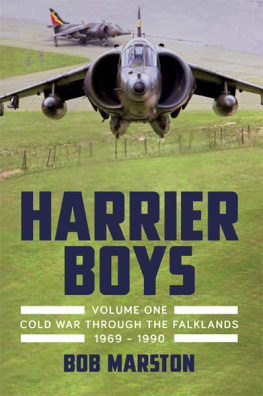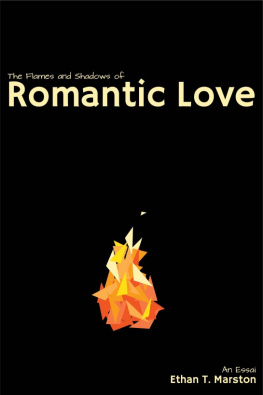PUBLISHERS NOTE
From time to time Bob Marston has written a short introductory piece to the chapter written by the named contributor. Bobs piece has been indented for clarification purposes.
This book is dedicated to those Harrier Boys who didnt live to tell their tales.
Published by
Grub Street
4 Rainham Close
London
SW11 6SS
Copyright Grub Street 2015
Copyright text Bob Marston 2015
A CIP record for this title is available from the British Library
ISBN-13: 9781909808294
eISBN-13: 9781910690826
All rights reserved. No part of this publication may be reproduced, stored in a retrieval system, or transmitted in any form or by any means electronic, mechanical, photocopying, recording or otherwise, without the prior permission of the copyright owner.
Printed and bound by Finidr, Czech Republic
CONTENTS
Dick Johns |
Graham Williams
|
Peter Dodworth
|
Graham Williams, Heinz Frick
|
Steve Jennings
|
Pat King
|
Bomber Harris
|
Chris Burwell, Bob Marston
|
Gavin Mackay, Keith Marshall
|
Peter Squire
|
David Morgan
|
Syd Morris
|
Pat King, Mike Beech, Gavin Mackay
|
Bob Marston, Dave Oakley
|
Chris Burwell, Mike Beech, Ashley Stevenson
|
Bob Webster, Bob Heyhoe, Martin Bean, Mark Smith, Roger OLoughlin, Dave Ellis, Tony Yeates
|
Pete Day
|
Bob Marston, Dave Oakley, Mike Harwood
|
Bob Marston
|
FOREWORD
Air Chief Marshal Sir Richard Johns GCB KCVO CBE FRAeS

Group Captain Bob Marston completed four flying tours as a Royal Air Force Harrier pilot between 1975 and 1989. Three were on operational squadrons (1 [F] Squadron, 3 [F] Squadron and 4 [AC] Squadron) and the fourth was as an instructor on the Harrier Operational Conversion Unit. He is thus well placed to draw together a miscellany of contributions from Royal Air Force and Royal Navy sources that record from personal experiences the Harrier history from its introduction to service in 1969 until the end of the Cold War. At the conclusion of this confrontation the first generation Harrier was replaced by the much more capable Harrier Mk 2.
An account of the Harriers continuing development will be covered in a second volume which will conclude with the sale of the RAFs fleet of 72 Harriers to the US Marine Corps. This was but one consequence of the 2010 Strategic Defence and Security Review, which had precious little to do with strategy and everything to do with cutting the defence budget irrespective of capability repercussions.
The testimonies in this book are more about people than a technical history of an aeroplane that made its own unique contribution to the nations strategic concerns in the later years of the Cold War. While the geographic focus of the confrontation was in Central Europe, the Falklands War finally dispelled any doubts about the operational robustness of the aircraft. The Falklands conflict, an enterprise of huge strategic risk, could not have been won without the potency of Fleet Air Arm and RAF Harriers flown with an abundance of courage and skill.
Recollections of the Falklands War from RN and RAF pilots quite properly constitute the central piece of this volume. Elsewhere, others recall detachments to Belize, first in 1975 and then again in 1977, which forestalled Guatemalan claims to sovereignty over the territory. After independence in 1981 a flight of Harriers remained to provide protection against any further threat from Guatemala.
The Falklands and Belize operations provided conclusive proof of the inherent flexibility of the Harrier and its contribution to strategic effect. And while Harriers operated routinely on the northern and southern flanks of NATO, the largest commitment of the Force from the early 1970s to the end of the Cold War was in RAF Germany. The majority of Harrier people served there at one time or the other mastering the tough challenge of off-base field deployments while generating combat air power in support of the Northern Army Group.
Three times a year the RAF Germany Harrier Force trained in an unfamiliar environment far removed from the concrete certainties and comparative comfort of main base operations. The complexities of life on the ground where terrain and weather often combined to present novel and testing difficulties required the development of a particular mindset; one that was sensitive to risk but quick to discern operational opportunities. The development of the necessary professional skills and acceptance of responsibility tested leadership at all levels in the Force. In particular, the leadership of site commanders in the rank of squadron leader responsible for the operation of six aircraft, with soldiers from the Royal Engineers and Royal Signals also under command, was tested to the point that supporting, engineering and flying the aircraft were almost taken as a given. Contributors to this volume give the reader a taste of the reality of Harrier field operations.
Within the RAF, and I suspect the RN, Harrier pilots gained a certain reputation not hallmarked by either reticence or modesty. But the testimonies in this volume are distinguished by the admission of mistakes and a pleasing addiction to truth. And while the contributors are a varied and eclectic bunch that defies categorisation, they all share common pride in being Harrier Boys. It was my great privilege to enjoy their company for two tours in the Harrier Force. Nothing in my service career gave me greater pleasure than this association.
CONTRIBUTORS
(in order of rank)
Dick Johns
Air Chief Marshal Sir Richard Edward Johns GCB KCVO CBE FRAeS was Chief of the Air Staff from 1997 to 2000. He commanded 3 (F) Squadron as a Harrier GR3 squadron at RAF Wildenrath and RAF Gtersloh, returning to the latter as station commander and RAFG Harrier Force commander. Later, he was AOC 1 Group.
Peter Squire
Air Chief Marshal Sir Peter Ted Squire GCB DFC AFC DL FRAeS was Chief of the Air Staff from 2000 to 2003. He served on 3 (F) Squadron as a flight commander under Dick Johns, commanded 1 (F) Squadron during the Falklands War, was station commander of RAF Cottesmore, and was AOC 1 Group. He was a member of No 16 Harrier Course, along with Bob Marston.
Peter Dodworth
Air Vice-Marshal Peter Dodworth CB OBE AFC DL was a member of the original Harrier Conversion Team. He was OC Ops Wg at RAF Wittering, Air Commander Belize, station commander RAF Wittering and Air Attach in Washington.
Bomber Harris
Air Vice-Marshal Peter Bomber Harris AFC flew Harriers on 20 Squadron and 1 (F) Squadron, commanded IV (AC) Squadron in Gtersloh, RAF Laarbruch as a Harrier station, and was AOC 1 Group.
Gavin Mackay
Air Vice-Marshal Hector Gavin Mackay CB OBE AFC FRAeS flew Harriers on 3 (F) Squadron, as a flight commander on 1 (F) Squadron with Peter Squire as his OC, and as station commander of RAF Gtersloh. During his first tour as a Jet Provost QFI, one of his students was Bob Marston.
Mike Harwood
Air Vice-Marshal Michael John Harwood CB CBE ADC flew Harriers as a flight commander on 1 (F) Squadron. He commanded 20 (R) Squadron and RAF Cottesmore.
Next page















